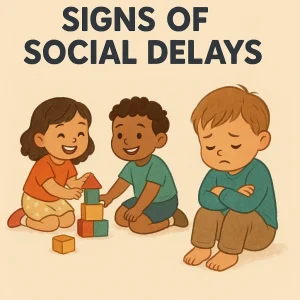Understanding the 3 Key Domains in Autism Testing
Last Updated: September 30, 2024
Understanding autism testing can feel overwhelming, especially if you’re unsure where to begin or what’s being evaluated. If you’re a parent, caregiver, or someone supporting a loved one with autism, breaking down the process into simple steps can help. The good news? Autism testing focuses on three main areas: communication, social interaction, and repetitive behaviors. These core domains provide a clearer picture of how an individual experiences the world. Think of them as the puzzle pieces that help professionals uncover a person’s strengths and challenges, making it easier to offer the right support and guidance.
Discover your child’s developmental needs with our Autism Screening Tests—click here to start now!
Understanding Autism Testing: 3 Core Domains
When professionals evaluate someone for autism, they often focus on three main areas: Communication, Social Interaction, and Repetitive Behaviors. These domains serve as the key pillars of autism testing and help in understanding the unique challenges and strengths an individual may have. Together, they form a comprehensive view of how someone on the spectrum experiences the world.
1. Communication: The Language and Expression Domain
Communication encompasses more than just speaking; it includes understanding language, gestures, facial expressions, and even the tone of voice. For someone with autism, expressing their thoughts and interpreting what others say might not come naturally. While some may struggle to find the right words, others may understand language in a very literal way, making it hard to pick up on metaphors or implied meanings.
This domain helps testers identify challenges with both verbal and non-verbal communication, making it easier to find ways to support the individual’s specific needs. Understanding this domain is critical for promoting better interactions and connections with others.
2. Social Interaction: Understanding and Engaging with Others
Social interaction focuses on how someone relates to and engages with others. This domain explores how an individual perceives social cues, builds relationships, and understands the perspective of others. It’s not about whether someone wants to make friends—many people with autism have a strong desire to socialize—but rather how they navigate social situations, which can sometimes be tricky and confusing.
Imagine a social situation where facial expressions, tone, and body language convey messages; those with autism might find it challenging to decode these subtle cues, leading to misunderstandings. Evaluating social interaction helps to uncover these nuances and build appropriate social skills, fostering more meaningful and comfortable relationships.
3. Repetitive Behaviors: Physical and Sensory Patterns
Repetitive behaviors are a core aspect of autism and are closely related to how individuals process sensory input. These behaviors can include things like repetitive speech, body movements (e.g., rocking, hand-flapping), and even having strong preferences for routines or specific interests. For many individuals with autism, these behaviors provide comfort, help them organize their thoughts, or serve as a way to cope with overwhelming sensory experiences.
Understanding repetitive behaviors is not about stopping them but recognizing how they help the individual regulate their emotions and sensory input. Testing in this domain helps professionals and caregivers support the person in ways that respect their need for these behaviors while promoting their well-being.
How the Domains Are Interconnected
While each domain—Communication, Social Interaction, and Repetitive Behaviors—stands alone in testing, they are deeply interconnected. For example, a person struggling with verbal communication might also find it difficult to engage in social settings. Similarly, repetitive behaviors might impact social interactions or help the individual manage social anxiety. Understanding how these domains overlap is key to providing tailored support that addresses the full range of someone’s needs.
By evaluating all three domains together, professionals can gain a holistic understanding of how autism affects an individual’s day-to-day life. It’s not about fitting someone into a category but rather understanding their unique way of experiencing the world, which is crucial in providing the right interventions and support.
Domain 1: Language Deficits (Communication)
Understanding Communication Challenges
One of the primary areas that autism testing focuses on is communication—how someone expresses their thoughts, understands what others say, and even interprets body language. Communication is a fundamental part of human connection, and for individuals with autism, it can be one of the most challenging domains to navigate. This isn’t just about speaking clearly; it includes verbal communication, like forming sentences, and non-verbal cues, such as facial expressions, gestures, and tone of voice.
For some individuals on the autism spectrum, understanding language can be a bit like piecing together a puzzle. Words might not always connect naturally to their meanings, or phrases that others take for granted can be confusing. It’s like hearing the word “banana” but not immediately associating it with the fruit. This gap in understanding makes it challenging to pick up on social nuances or have smooth conversations.
How It Manifests
Language deficits in autism can show up in many different ways. Some people may struggle to find the right words when they speak, while others might take language very literally. For instance, when someone says they’re “feeling blue,” a person with autism might wonder why they don’t see an actual blue color, as they interpret the phrase literally instead of associating it with feeling sad.
These communication challenges can vary widely. Some may have trouble with back-and-forth conversations, not knowing when to speak or how to respond. Others may find it difficult to understand sarcasm, jokes, or idioms that rely on implied meanings. For example, a simple expression like “break a leg” (which means “good luck”) may be confusing without understanding the context.
It’s important to remember that language deficits are not necessarily tied to intelligence. Many individuals on the autism spectrum can be incredibly articulate in writing but find verbal conversations to be more challenging. Autism testing helps uncover these unique patterns to provide better support and strategies for effective communication.
Why It Matters in Testing
Assessing communication is crucial in autism testing because it lays the foundation for interaction with the world. Early intervention in communication can significantly impact how an individual learns to connect with others, express their needs, and understand social cues. The sooner these challenges are recognized, the earlier targeted support can begin, making it easier to build essential skills over time.
By evaluating language deficits, professionals can identify whether someone struggles with understanding and using language and provide tools to enhance their communication. This is why language and communication testing form a significant part of autism diagnosis and therapy.
Understanding Social Interaction Difficulties
Social skills are a central part of daily life—whether it’s making friends, interpreting someone’s feelings, or simply having a conversation. For individuals with autism, these social interactions can be challenging, as they often struggle with understanding and responding to social cues. Autism testing evaluates these key areas of social skills, which include recognizing facial expressions, interpreting body language, and engaging in reciprocal (back-and-forth) conversations. The goal is to understand how someone with autism perceives social contexts and where they may need additional support.
This domain of social interaction is about more than knowing how to make small talk; it’s about understanding the unspoken rules of social engagement. Imagine a child who wants to join in a playground game but doesn’t know how to approach the group or read the other kids’ facial expressions to see if they are open to playing. Such challenges can make social situations stressful and confusing.
How It Manifests
Social deficits can present themselves in different ways. Some individuals may find it hard to read facial expressions or body language; a smile might not immediately indicate happiness, or crossed arms might not be seen as a sign of discomfort. Others may struggle with understanding social contexts—knowing how to behave at a birthday party versus in a classroom, for example.
Additionally, many people with autism have difficulty with perspective-taking, which means understanding what another person might be thinking or feeling. For instance, if a person with autism sees someone with a flushed, red face after exercise, they might assume that person is angry, missing the context of physical exertion. This can lead to misinterpretations and social misunderstandings.
These social deficits don’t mean that a person with autism does not want to connect or make friends; often, they want social interaction but might not know how to approach it or maintain it comfortably.
Why It Matters in Testing
Social skills evaluation is a crucial part of autism testing because social deficits significantly impact relationships and day-to-day interactions. By understanding where social challenges exist, professionals can help create strategies to improve social skills, teach emotional understanding, and provide guidance on how to navigate complex social settings.
Early assessment of social skills and tailored support can make a huge difference in how someone on the autism spectrum forms meaningful relationships and feels confident in social settings. Testing helps identify specific social strengths and areas of growth, ensuring that interventions are targeted and effective.
Domain 3: Repetitive Behaviors (Physical and Sensory)
Understanding Repetitive Behaviors
When we think about repetitive behaviors in autism, we often picture actions like hand-flapping, rocking, or repeating phrases over and over again. But it’s important to understand that these behaviors are much more than simple habits. For many individuals on the autism spectrum, these repetitive actions serve as a way to process sensory experiences and regulate emotions.
Imagine feeling overwhelmed by sights, sounds, or even emotions, and needing something familiar and soothing to regain focus. For those with autism, repetitive behaviors provide that comfort and consistency, acting as a way to cope with an environment that may otherwise feel unpredictable and overstimulating.
These behaviors are also linked to routines and rituals. Whether it’s following the same morning routine or being particular about how toys are lined up, routines can provide a sense of control and predictability that helps an individual with autism feel secure and organized.
How It Manifests
Repetitive behaviors may manifest in different ways for different people. Some common examples include:
- Physical movements like hand-flapping, rocking back and forth, or spinning.
- Repetitive speech or sounds, such as repeating a favorite phrase or sound (sometimes called echolalia).
- Focused interests or routines, such as wanting to talk about the same topic over and over again or feeling distressed if a routine is disrupted.
Why It Matters in Testing
Repetitive behaviors are one of the primary aspects evaluated in autism testing because they provide a window into how an individual interacts with and interprets their environment. Identifying these behaviors helps professionals understand an individual’s needs and how they regulate their sensory experiences. Moreover, these behaviors can point to specific areas where support might be needed—whether it’s helping someone build alternative coping strategies or embracing routines that foster comfort and confidence.
Evaluating the physical domains of autism—like repetitive movements and sensory patterns—also helps families and caregivers better understand how to support their loved ones effectively. Rather than focusing on stopping these behaviors, the goal is to understand their purpose and find positive ways to manage them if they interfere with daily life.
Signs to Look For in Each Domain
| Domain | Signs to Look For |
| Communication | – Limited Language: Few spoken words or limited vocabulary compared to peers. – Delayed Speech: Not meeting speech milestones (e.g., speaking in phrases by age 2-3). – Struggles with Gestures: Limited use of pointing, waving, or head nodding/shaking. – Difficulty with Non-Verbal Cues: Challenges understanding body language, facial expressions, or tone. |
| Social Skills | – Avoids Eye Contact: Minimal or no eye contact during interactions. – Difficulty Making Friends: Trouble starting or maintaining play and conversations. – Lack of Response to Name: Inconsistent response when called by name. – Misunderstanding Emotions/Tone: Takes things literally; difficulty understanding jokes, sarcasm, or others’ emotions. |
| Repetitive Behavior | – Repetitive Movements: Hand-flapping, spinning, or rocking back and forth. – Strict Routines: Upset by changes in routines or daily activities. – Repeating Phrases (Echolalia): Repeats words, sounds, or phrases heard from others, TV, or songs. – Intense Focus on Specific Interests: Strong attachment to specific topics, objects, or activities. |
The Role of Early Identification and Support
Why Early Testing is Important
When it comes to autism, early identification and support are key to ensuring that an individual receives the right interventions to thrive. By understanding the three core domains of autism testing—communication, social interaction, and repetitive behaviors—families and professionals can provide tailored support to address specific challenges and build on strengths.
Early testing helps professionals and families understand where a child or adult may need additional assistance. For example, if a child shows communication challenges, language therapy can be introduced early to help build those skills. If social deficits are identified, specific social skill-building activities can be developed to help the child navigate interactions with others. And by recognizing repetitive behaviors, families can better understand the child’s sensory needs and create environments that support comfort and well-being.
Think of early testing as a roadmap—it not only tells you where a person is on their journey but also provides guidance on the best ways to reach their full potential. Intervening early can pave the way for improvements in skills, relationships, and self-confidence, providing a more positive outlook for the future.
Supporting Your Loved One Through the Journey
Navigating Challenges with Knowledge
Navigating the journey of autism can be both rewarding and challenging. But here’s the empowering truth: understanding the core domains of autism—communication, social interaction, and repetitive behaviors—equips you with the knowledge to provide meaningful support. As a family member, educator, or caregiver, recognizing how these domains affect a person’s experience of the world is the first step in making a positive difference in their life.
Every individual with autism is unique, and so are their needs. By understanding how they communicate, socialize, and manage their sensory experiences, you can help create an environment that fosters growth, comfort, and connection. Whether it’s encouraging better language use, facilitating smoother social interactions, or finding ways to support sensory regulation, your informed support can make a significant impact.
Remember, it’s not about changing who they are but about helping them thrive in their own way. The journey may have its ups and downs, but with the right knowledge and guidance, you can help your loved one live a more fulfilling and connected life.
Conclusion
Understanding the three core areas of autism—communication, social interaction, and repetitive behaviors—can truly transform the way we provide support. By recognizing each individual’s unique strengths and challenges, we can offer more personalized interventions that make a real difference in their daily life. Early identification and timely support are crucial to unlocking a child’s potential and enhancing their learning journey. Remember, you’re not alone in this process. Wellness Hub is here to guide you every step of the way. Visit our website for more insights and resources on autism testing and early intervention. Every step matters towards a brighter future!
Frequently Asked Questions:
1. What are the three core domains of autism testing?
The three core domains of autism testing are communication, social interaction, and repetitive behaviors. These areas help professionals understand an individual’s unique challenges and strengths, guiding tailored support and intervention.
2. How do communication deficits manifest in autism?
Communication deficits in autism may appear as difficulties in processing language, understanding non-verbal cues, or engaging in conversation. For example, a person might take phrases literally or struggle to interpret facial expressions.
3. Why is social interaction important in autism testing?
Social interaction skills are crucial because they affect how an individual with autism engages with others. Testing in this domain helps identify challenges in understanding social cues, building relationships, and interpreting social contexts.
4. What role do repetitive behaviors play in autism?
Repetitive behaviors are often a way for individuals with autism to manage sensory input and cope with emotions. Actions like rocking, repeating words, or sticking to routines can provide comfort and help with self-regulation.
5. Why is early autism testing and intervention important?
Early autism testing helps identify the specific needs of an individual, allowing for tailored support and intervention. Early intervention can improve communication, social skills, and help manage repetitive behaviors, positively impacting long-term development.
6. How does understanding these domains help support individuals with autism?
Understanding the core domains of communication, social interaction, and repetitive behaviors allows caregivers and professionals to provide better support. This knowledge helps tailor interventions, enhance social skills, and build better communication strategies.
7. What are the signs to look for when seeking autism testing for a child?
Some signs include difficulties in communication, challenges in social interactions, and repetitive behaviors. If you notice any of these in your child, it may be helpful to consult a professional for an evaluation.
8. Can early intervention improve social skills in children with autism?
Yes, early intervention can significantly improve social skills. Therapy and support tailored to the child’s needs can help them better understand social cues, build relationships, and engage in meaningful interactions.
9. Where can I find resources and support for autism testing and early intervention?
Platforms like Wellness Hub provide a variety of resources, expert guidance, and support for autism testing and intervention.
10. How do repetitive behaviors in autism affect daily life?
Repetitive behaviors can serve as coping mechanisms for sensory processing and managing emotions. While they provide comfort, they can also affect daily routines and social interactions, making it important to understand and support these behaviors.
About the Author:
Anuradha Karanam
Speech-language pathologist (7+ years of experience)
Anuradha Karanam is a skilled speech-language pathologist with over 6 years of experience. Fluent in Tamil, Telugu, Hindi, and English, she specializes in parent counseling, speech sound disorders, fluency assessment, and speech-language evaluations. Anuradha excels at working with children with developmental disorders, offering creative and effective therapy programs. Currently, at Wellness Hub, she holds a BASLP degree and is registered with the RCI (CRR No A85500). Her patience, ambition, and dedication make her a trusted expert in her field.
Book your Free Consultation Today
Parent/Caregiver Info:
Client’s Details:
* Error Message









